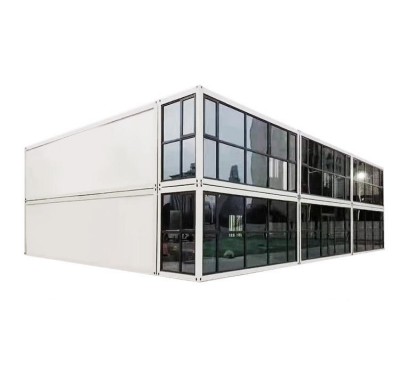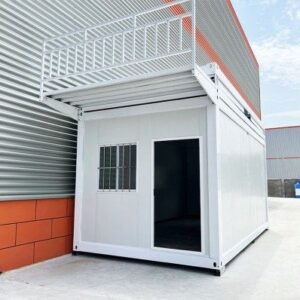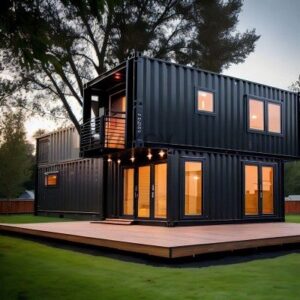If you’re wondering how much for a shipping container house and what drives the price, you’re in the right place. Shipping container homes are reshaping affordable housing, but the real costs aren’t always obvious upfront. In this guide, you’ll get a clear breakdown of expenses—from container purchase to permits, modifications, and more—plus smart tips to keep your budget on track. Ready to see what building a container house really costs? Let’s get started.
What is a Shipping Container House
A shipping container house is a home built using steel containers originally designed for cargo transport. These container homes have grown popular due to their affordability, durability, and flexibility. They offer a unique approach to housing by repurposing containers into livable spaces, which can range from simple tiny homes to multi-container custom residences.
Benefits of Shipping Container Homes
- Cost Efficiency: Compared to traditional construction, building with containers can lower material and labor costs.
- Speed of Construction: Containers arrive pre-fabricated, making the home build faster.
- Durability: Made from weather-resistant steel, these homes stand strong against harsh weather.
- Sustainability: Repurposing containers helps reduce waste and promotes environmentally friendly living.
- Mobility: Container homes can be relocated more easily than conventional houses.
- Modern Aesthetic: Their industrial look appeals to those who want a contemporary, minimalist design.
Types and Sizes of Shipping Containers Used in Homes
Most container houses use standard shipping containers in two main sizes:
- 20-foot containers (approx. 160 sq ft)
- 40-foot containers (approx. 320 sq ft)
Homebuilders can choose between new or used containers. New containers cost more but come with a warranty and fewer structural issues. Used containers are less expensive but may require extra work like rust treatment or reinforcement.
Containers might also vary by height:
- Standard height: 8.5 ft
- High cube: 9.5 ft, offering additional interior space
Lifestyle and Sustainability Appeal of Container Homes
Many people are attracted to container homes for the lifestyle freedom and eco-friendly benefits they provide:
- Compact and efficient living space encourages minimalism
- Low environmental footprint means lower utility bills and reduced energy use
- Possibility to integrate off-grid systems such as solar panels and rainwater harvesting
- Ideal for locations where traditional building materials may be costly or restricted
Container houses can be tailored for different climates and lifestyles, making them a versatile option for modern homeowners looking for something affordable, sustainable, and stylish.
For a detailed view on pricing and container options, check out how much container houses cost and explore popular models like the 20ft and 40ft expandable container house with solar energy.
Factors That Affect the Cost of a Shipping Container House
When figuring out how much for a shipping container house, several key factors impact the overall price. Understanding these can help you budget better and avoid surprises.
Container Purchase Price New vs Used and Size Considerations
The initial cost starts with the container itself. New containers generally cost more but come in better condition and with warranties, while used containers offer a cheaper option but may require more repairs. Size also plays a big role:
- 20ft containers are more affordable but offer less living space.
- 40ft containers provide more room but come with a higher price tag.
Choosing based on your space needs and budget is crucial. For details on container sizes, check out this 20-foot container house layout.
Site Preparation and Foundation Expenses
Your site’s condition will affect costs. Uneven land or difficult terrain means more work, which drives up expenses. Foundation types also vary:
- Concrete slabs are common but pricier.
- Piers or gravel foundations can be more affordable but depend on local codes.
Site prep and foundations typically run from a few thousand to tens of thousands depending on complexity.
Design Complexity and Customization Level
The more unique your design, the higher the cost. Simple box-style homes cost less, but:
- Custom shapes, additional floors, or unique features raise prices.
- Adding windows, decks, or cutting large openings affects structural work and costs.
If you want a more detailed design guide, see how to make a shipping container house.
Interior Modifications Insulation Plumbing Electrical HVAC
Finishing the inside is one of the biggest expenses:
- Insulation is critical for temperature control; costs vary by material (spray foam is pricier than blanket insulation).
- Installing plumbing and electrical wiring must meet code, affecting price.
- HVAC setup depends on your climate and system choice.
These often add thousands to your total budget but are essential for comfort and functionality.
Permits and Regulatory Fees Local Zoning and Building Codes
Permitting can’t be ignored. Prices vary widely:
- Building permits can range from a few hundred to several thousand dollars.
- Some areas have strict zoning and code requirements that can add both delays and costs.
Always check local regulations before committing.
Labor and Contractor Fees
Unless you’re going fully DIY, hiring professionals is necessary:
- Labor costs vary significantly across regions in the US.
- Skilled trades like welders, electricians, and plumbers charge accordingly.
- Experienced container home builders might cost more but save time and assure quality.
Labor typically forms a substantial portion of container home construction cost.
Transportation and Delivery Costs
Shipping the container to your site isn’t free:
- Delivery fees depend on distance from the port or storage yard.
- Larger containers and difficult access increase charges.
- Some companies offer package deals that include delivery.
If you’re curious about delivery expenses and total pricing, see this detailed container house cost guide.
Average Cost Breakdown for Shipping Container Houses
When figuring out how much for a shipping container house, it helps to understand the typical costs involved, which vary a lot depending on your approach and needs.
Basic DIY Container Home Cost
If you’re handy and want to build a simple container home yourself, expect to spend between $10,000 and $35,000. This usually covers:
- Buying a used 20ft or 40ft container (used containers are cheaper but need more work)
- Basic site prep and foundation work
- Minimal interior finishing (basic insulation, simple electrical setup)
DIY projects save money on labor but require more time and skill.
Mid-Range Finished Container Houses
Hiring professionals to create a move-in ready container home will push costs to around $60,000 to $120,000. This usually includes:
- Professional design and building services
- Better insulation, plumbing, electrical, and HVAC systems
- Multiple containers combined or stacked for extra space
- Moderate to high-quality finishes
Mid-range options strike a balance between cost, quality, and ease.
High-End Custom Container Homes
Luxury container homes with custom layouts and premium finishes can easily cost $150,000 and up, even reaching $250,000+ depending on features like:
- Multiple containers with complex structural changes
- High-end appliances and eco-friendly, energy-efficient systems
- Custom interior finishes, smart home tech, and landscaped outdoor areas
These homes often rival traditional housing prices in upscale neighborhoods.
Cost Comparison by Container Size
- 20ft container home: Lower upfront cost, less living space, roughly $10,000 to $50,000 depending on finish and location.
- 40ft container home: More space and flexibility, prices range from $20,000 to $120,000+ with professionals involved.
Choosing between sizes depends on your budget and space needs.
Container Home vs Traditional Home Cost Analysis
In many U.S. locations, particularly urban areas, container homes can be 20-40% cheaper than building a traditional home from scratch. However:
- Site prep and permits vary by location and can reduce savings
- Container homes offer faster build times, which lowers some costs
- Traditional homes generally have fewer design restrictions and more resale market familiarity
In rural areas with less strict zoning, container homes tend to be much more affordable. But in bigger cities, permit and delivery fees can add up quickly, narrowing the cost gap.
Understanding these cost layers helps you plan better for a shipping container house fitting your budget and lifestyle.
Local Pricing Considerations for Shipping Container House Cost
When figuring out how much for a shipping container house, location plays a big role in your overall expenses. Here’s what you need to know about local pricing factors:
Urban vs Rural Cost Differences
- Urban areas usually have higher costs due to more expensive labor, stricter regulations, and limited space, which can add to site preparation and foundation expenses.
- Rural locations often mean cheaper land and fewer building restrictions but may increase delivery costs if sites are remote or hard to access.

Regional Labor Costs in the US
Labor rates vary widely across the United States. For example:
- Coastal cities like San Francisco or New York charge significantly more for contractors and skilled labor.
- Midwestern and southern states tend to have lower labor costs, which can reduce your container home construction cost overall.
Impact of Local Building Codes and Permits
Each state and municipality sets its own building codes for container homes. Some areas may:
- Require strict modifications for structural safety, electrical work, or insulation, driving up costs.
- Charge higher permit fees or demand inspections, adding to your budget.
- Others may be more lenient, making it cheaper and faster to get started.
Shipping and Delivery Costs Vary by Location
The cost to transport shipping containers to your site depends on:
- Distance from the port or container yard—closer means cheaper delivery fees.
- Access to the site—difficult terrain or narrow roads can raise transport expenses.
- Local regulations on heavy vehicle usage may also affect timing and cost.
your location shapes much of the cost to build a container home. Urban vs rural settings, regional labor rates, local codes, and delivery logistics all affect your final shipping container house price. Planning around these factors helps manage your budget more effectively.
How to Save Money When Building a Shipping Container House
Building a shipping container home can be affordable if you know where to cut costs without sacrificing quality. Here are practical ways to save money on your container home project:
Buy Affordable Shipping Containers
- Consider used containers: Used shipping containers are significantly cheaper than new ones and still sturdy enough for homes if inspected properly. Look for containers in good condition to avoid costly repairs.
- Source locally: Buying containers nearby reduces transportation and delivery fees, a big chunk of the overall cost.
- Compare sellers: Check multiple suppliers, including online marketplaces and local yards, to find the best price and condition.
DIY vs Hiring Professionals
- DIY benefits: Doing basic modifications yourself—like prepping the interior or simple insulation—can save thousands in labor costs.
- Know your limits: Complex tasks like structural welding, electrical, and plumbing work usually require professionals to ensure safety and code compliance.
- Hybrid approach: Hire contractors for technical work while handling painting, basic finishings, and landscaping on your own to balance costs and quality.
Simplify Design to Reduce Cost
- Keep the design straightforward: Boxy, modular layouts that stick to standard container sizes require less cutting and welding, saving on labor.
- Limit extensive customization: Custom windows, doors, and unique shapes add to both material expenses and labor hours.
- Use container house kits: Prefabricated container house kits lower design and construction costs because they come with pre-planned modifications. See options like 20-foot container tiny houses for affordable models.
Reuse and Sustainable Materials
- Recycled materials: Use reclaimed wood, fixtures, and insulation where possible to reduce material expenses.
- Salvage items: Doors, cabinets, and furniture can often be repurposed to save money and add character.
Keep Landscaping and Utilities Simple
- Minimize landscaping: Natural landscaping or simple gravel patios reduce upfront site costs.
- Consider off-grid options: Solar panels, rainwater collection, and composting toilets avoid expensive utility hookups and ongoing bills but require upfront investment. Off-grid setups can be cost-efficient long-term, especially in rural US locations.
By focusing on these money-saving measures—sourcing affordable containers, mixing DIY with professional help, sticking to simple designs, and reusing materials—you can build a high-quality, cost-effective shipping container home without breaking the bank. For more detailed cost planning, check out our guide on how much it costs to build a container house.
Is a Shipping Container House Worth the Investment
When considering the cost of a shipping container home, one important question is whether it’s truly worth the investment compared to traditional building methods. Let’s break down the factors that matter most: longevity, resale value, environmental benefits, lifestyle appeal, and financing options.
Longevity and Durability of Container Homes
Shipping container houses are built from high-strength steel, designed to withstand harsh ocean conditions. This makes them exceptionally durable, resistant to pests, fire, and extreme weather when properly maintained. Unlike wood-framed homes, containers don’t rot or suffer from termite damage, which can save you long-term maintenance costs.
Key point: A well-maintained container house can easily last 50+ years, making it a solid long-term investment.
Resale Value Compared to Traditional Homes
While resale value depends heavily on location and design, container homes generally hold their value well because they appeal to a niche market looking for sustainable, modern living spaces. Custom, well-finished container homes with good insulation, plumbing, and electrical systems can attract buyers willing to pay a premium.
Still, they may not appreciate at the same rate as traditional houses in some neighborhoods, so it’s smart to research your local market. In many U.S. cities, interest is growing in alternative housing, which boosts container home demand.
Environmental and Lifestyle Benefits
One of the biggest advantages of container homes is their environmental friendliness. They repurpose unused or retired shipping containers, reducing waste and the need for new building materials. Plus, their compact size and efficient design trim down energy use, especially when combined with solar panels or off-grid setups. This appeals to eco-conscious buyers, lowering your carbon footprint without sacrificing comfort.
Lifestyle-wise, container homes offer flexibility and speed of construction, making them perfect for those valuing minimalism, mobility, and modern aesthetics.
Financing Options and Return on Investment
Financing a shipping container house can be more challenging than a traditional mortgage since many lenders view them as non-standard homes. However, specialized lenders and personal loans are options if you plan carefully. Some container home builders offer financing packages or kits that simplify this process.
In terms of return on investment, lower construction and maintenance costs compared to traditional homes can lead to higher equity over time. Plus, energy savings from good insulation and efficient systems reduce monthly expenses, improving your overall financial outlook.
For detailed tips on how to manage your shipping container house expenses and design, check out our guide on how to build a shipping container house. If you’re considering a smaller, affordable option, exploring the 20-foot container tiny house might be a smart move.
Frequently Asked Questions about Shipping Container House Costs
Can I Build a Shipping Container Home Under $20,000
Yes, building a container home for under $20,000 is possible, but it usually means a very basic setup. A simple DIY project using used containers, minimal interior work, and no major plumbing or electrical systems can fit this budget. However, expect to do much of the work yourself, limit customization, and keep the design simple. Costs for permits, site prep, and delivery may push prices higher, so planning carefully is key.
How Much Do Permits and Regulatory Fees Usually Cost
Permits and local fees vary widely depending on your location and the complexity of your shipping container house. On average, permit costs range from $500 to $3,000, sometimes more in urban areas with strict zoning laws. These fees cover building permits, inspections, and any site-specific approvals. Be sure to check local city or county regulations because some places treat container homes like traditional builds, while others have special rules.
Are Used Shipping Containers Safe and Affordable to Use
Used shipping containers are generally safe and more affordable than new ones, often costing 30-50% less. They’re made of durable steel designed to withstand harsh conditions, but you’ll want to:
- Inspect for rust, dents, or structural damage
- Check if they were previously used for hazardous materials
- Consider professional cleaning and treatment
Used containers are a popular choice to reduce the overall cost of container home construction without compromising too much on strength and durability.
What About Insulation and Climate Control Expenses
Insulating a shipping container house is critical and can impact your budget significantly. Basic insulation methods range from:
- Spray foam insulation (most effective but higher cost)
- Rigid foam panels (moderate cost and decent insulation)
- Fiberglass batts (lowest cost but risk of moisture issues)



